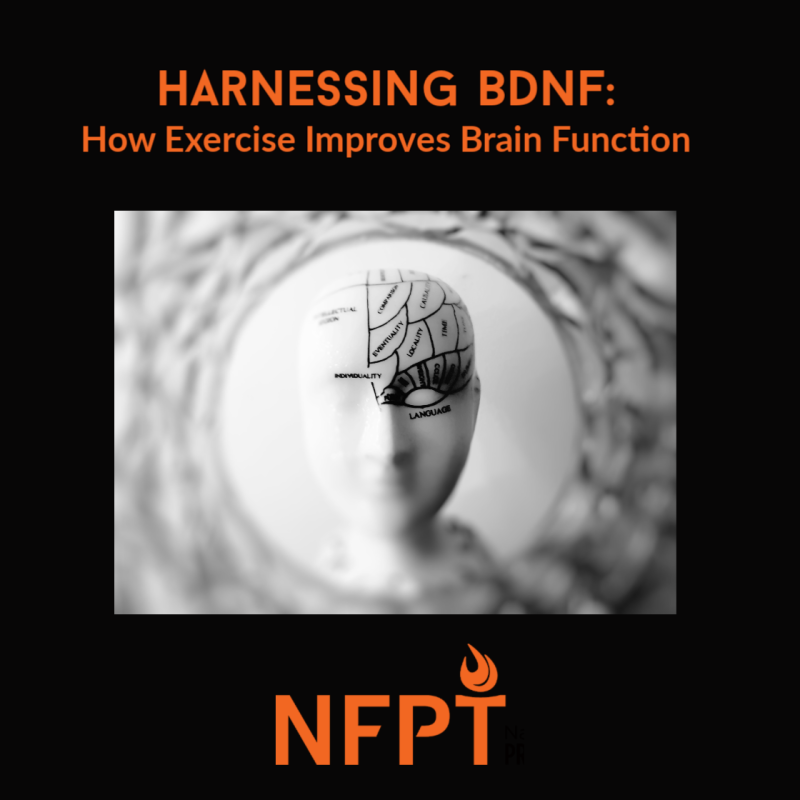
The effects of exercise are far-reaching when it comes to overall health and wellness, and science is revealing more and more every day. Most compelling is how much exercise, and specific ways of exercising especially, can impact brain functioning. Brain-Derived Neurotrophic Factor (BDNF) is a protein that promotes the survival of nerve cells by playing a role in the growth, maturation, and maintenance of these cells; it is released after even one short bout of exercise.
How BDNF Works
BDNF is a protein in your brain that is connected to a series of molecules and neurotransmitters. We can measure its effects in the hippocampus, the part of the brain related to memory retention. BDNF helps improve cognitive function and even works to alleviate depression and anxiety-related symptoms. The direct connection between exercise and BDNF function isn’t clear, even to scientists; however, if you think of the brain as just another organ in the body, then you can infer the relationship between the two. Just as your muscles and internal organs are positively impacted by exercise, so too is your brain. Exercise increases the amount of BDNF released in the brain.
Benefits of BDNF Production
BDNF has also been associated with a reduction in symptoms of anxiety and depression, as is regular exercise. It is hypothesized that exercise alleviates anxiety by simulating a “fight or flight” response that results in “pretend” danger. In other words, exercise tricks your body into thinking you are being threatened. (The same can be said for anxiety, which is what prompts overactivity in the brain and unpleasant physical symptoms like sweating, trembling, and tightness in the chest.) However, as you exercise, allowing time for breaks and a cool-down period, it becomes clear that there is no true threat. Exercise can help release the pent-up energy related to anxiety and it can train your body to recognize when something is not a true threat.
Researchers hypothesize that exercise releases chemicals that actually prevent the inhibition of BDNF production.
This interesting protein can also minimize the side effects of depression. Along with this brain-health protein production, the neurotransmitters endorphins and serotonin are also released, which are known repressors of depression.
BDNF production and neuroplasticity (also induced by exercise) has been known to delay age-related degenerative diseases like Alzeimher’s and Huntington’s Disease. It improves cognitive functioning overall, especially for older adults.
What Modalities Influence BDNF
What specific modalities or types of exercise influence BDNF the most? Several studies indicate that certain exercises are more effective than others are producing this powerful protein.
Balancing Exercises
A study performed on older adults suggests that balancing exercises influence BDNF, resulting in the delay of age-related degeneration of cognitive function. This study focused on three different groups: one that performed “classic balance exercises,” one that did virtual reality balancing exercises, and a control group that did not perform balancing exercises to measure differences. The group that performed that classic balance exercises showed the greatest increase in BDNF. Some examples of balancing exercises include yoga postures like standing head-to-knee, dancer, and warrior III.
High-Intensity Interval Training (HIIT)
Another study specifically tested HIIT exercises and the production of BDNF and found that the protein increased in test subjects once they had completed the exercise routine. In fact, it increased after just one HIIT session. However, this particular study also found that general physical exercise was also enough to increase levels.
Rowing
This particular study measured BDNF after the test subjects rowed “to the point of exhaustion,” after about four hours. This experiment concluded that, while BDNF does increase during exercise, it peaks during the recovery period. During the experiment, test subjects were instructed to lay down in the supine position for an hour following their 4-hour rowing session. It was then that the spike was measured.
Recovery Periods
In all of the above studies, some time was allowed to pass before BDNF was measured in the bloodstream. A cool-down period, then, seems vital to production. While general exercise is enough to increase BDNF in general (improving brain function and keeping emotional disorders and degenerative diseases at bay), the recovery period enables BDNF to flourish.
Programming BDNF-Boosting Workouts
Personal trainers devise exercise programs that are unique to their clients’ fitness levels and needs. In the same way, trainers can create exercise programs that can positively impact BDNF and overall brain function. Trainers can do this without even knowing that brain function is being impacted; it’s just one of the many benefits of certain types of exercise.
If you want to be more intentional about encouraging neuroplasticity with your clients, the following are some focused approaches to formulating a BDNF-boosting workout.
Sprints
Sprinting initially exerts more effort than long-distance running, but the exercise is also over much sooner. This exercise can increase your client’s heart rate in a short amount of time, getting them to race to a resting period, which can help increase BDNF even further.
Healthline suggests a rapid fluctuation between sprinting and resting: sprinting for 30 seconds, then recovering for 1 to 2 minutes. With each sprint, your client should increase their speed and energy.
Timed Obstacle Courses
Speed is the name of the game here, but with an obstacle course, you’re encouraging your client to think outside the track lane. Anything with stations can be an obstacle course, so you can make this exercise as creative as possible: Have your client jump rope, then bob and weave through cones, then have them do burpees — you get the idea! With this routine, you’re getting your client’s heart rate up, which can boost BDNF, but you’re also engaging them mentally, which can also help improve cognitive function.
Interval Training on Cardio Machines
Not only is interval training great for weight loss, but it can also help boost BDNF. Have your client use a cardio machine — treadmill, elliptical, stationary bike, stair master — on an interval setting so that the speed, and perhaps intensity or incline, fluctuates. This will make the recovery periods when they’re exercising with a little more leeway feel like a short break, which can help result in BDNF-boosting effects.
Balancing Exercises
You don’t have to be a yoga instructor to instruct your client to perform balancing exercises. There are a wide variety of balancing exercises your client can try: standing on one foot, doing so with eyes closed, hopping on one foot, walking in a straight line or on a balance beam, standing on a balancing board or BOSU, or for an extra challenge, kneeling and even standing stability ball.
Twists/Cross Exercises
Twists can be great for growing core strength, but another benefit is that both sides of your client’s body will be engaged. During cross-motions, your client is activating both sides of their brain, which can boost the BDNF protein and improve overall brain function. Some twists or cross exercises you can instruct your client to do are bird dogs, Russian twists (with or without a medicine ball), or bicycle crunches.
Cool Down, Deep Stretching
Since the recovery period after exercise is when the most BDNF is generated, it’s important to include a cool down in your client’s workout. This way, their heart rate can start to slow and they can reap that benefit even sooner. During the cooldown, you can instruct your client to do some deep stretches for at least five or more breaths (at least 30 seconds), like seated forward fold, butterfly stretches, and figure-4 leg hamstring stretches.
Days Off
The most important part of a workout routine for BDNF production is a day off. Rest and recovery days are when muscles start to heal and grow. Likewise, BDNF-boosting is taking place and doing its good work. Now, don’t let your clients get too excited. They have to have a steady workout routine before they can reap the benefits of their rest days, especially when it comes to brain health.
References
https://www.mdpi.com/2077-0383/8/11/1910
https://physoc.onlinelibrary.wiley.com/doi/full/10.1113/expphysiol.2009.048512








